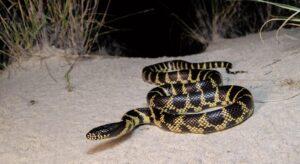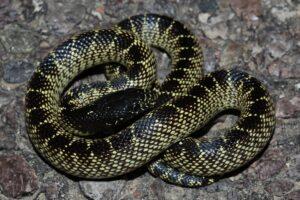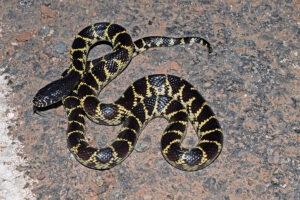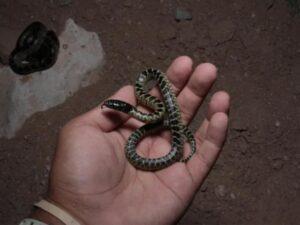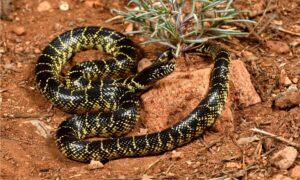The desert kingsnake is a long, slender, black and yellow snake belonging to the family Colubridae, the biggest snake family in the world. In the wild, they are not arboreal. They can climb but choose not to. The solitary and secretive snake can be tamed with regular handling and a good feeding routine.
Scientific Classifications
- Suborder:Serpentes
- Family:Colubridae
- Genus:Lampropeltis
- Species:L. splendida
Conservation Status
Description
Size
They attain sizes of 3-4 ft on average but can grow to 6.8 ft.
Color and Appearance
The glossy dorsal side of the snake is very dark brown or black, finely speckled with off-white or yellow. These dull flecks make inconspicuous narrow vertebral crossbands with black intervening rectangular areas. The lower sides of the body can have a predominance of pale yellow scales. Both adult and young snakes have mostly black abdomens with pale yellow or white blotches on the outer ends of the ventral plates. There are 23-25 rows of smooth dorsal scales arranged at the midbody, and the anal plate is not divided.
The hatchlings have bright yellow speckles in vertebral cross-lines. In addition to that, they exhibit a lateral row of big brown spots. As they mature, the brown spots are gradually encroached upon and fragmented by the yellow flecks.
Are They Dangerous to Humans
The non-venomous snake doesn’t cause any harm to humans. It is very docile when it encounters them. It may try to escape or ‘play dead’ in defense, faking the appearance of a dead snake by flipping over on its back and lying still.
Desert Kingsnakes at a Glance
Distribution
The desert kingsnake is a native of Arizona, New Mexico, and Texas in the United States.
Habitat
The snake occurs in rural areas within its range. Despite its name, it is mainly found in areas with well-balanced or moderate moisture levels, especially near water tanks and rivers. But it can adapt to various habitats, including forests, wetlands, and desert basins.
Lifespan
The desert kingsnake lives for 10-15 years.
Predators
Raccoons, hawks, and other raptors prey on it.
Diet
The powerful constrictor preys on lizards, rodents, and smaller snakes, including rattlesnakes. It can also eat reptile eggs buried underground, aided by its sense of smell. Its pitviper venom resistance enables it to eat young diamondback rattlesnakes. Even the adult western diamondbacks dread this species, defending their heads with loops when they smell its presence.
Reproduction
Oviparous (lays eggs that hatch outside the body)
After courtship and copulation occurring between March and June, clutches of 5-12 eggs having adhesive surfaces are laid in late June or July. They are sometimes buried almost 1ft deep to prevent drying as their shells are permeable to moisture. After an incubation period of about 60 days, 8-10-inch long hatchlings come out.
Care Sheet
Size of the Enclosure: The minimum enclosure size of a full-grown snake is 30 gallons. It should ideally be 40 inches (length) x 18 inches (width).
Temperature: 2/3rds of the tank should be the cool side maintained at 80°F during the day and 68-75°F at night. The remaining part should be the hot side with a temperature of 90°F.
Humidity: The humidity levels of the enclosure should be 50-75%.
Substrate: A natural substrate soft enough to allow burrowing is suitable for the pet. A 3-inch thick layer of aspen bedding or cypress mulch serves the purpose.
Feeding: The adults can be fed a frozen and defrosted rat or mouse of the same width or slightly bigger than the snake’s girth once a week. The young can be given a pinkie mouse every four days.
Source
reddit.com, inaturalist.ca, a-z-animals.com, everythingreptiles.com, shupewild.com

